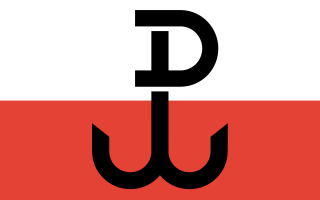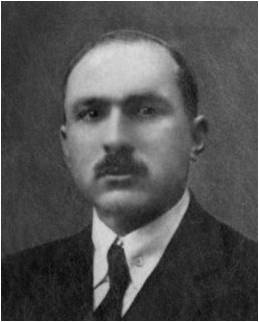| Part of a series on the |
| Underground State |
|---|
 |
Directorate of Underground Resistance (Polish : Kierownictwo Walki Podziemnej, KWP) was an agency of the Polish Underground State created during World War II. [1]
| Part of a series on the |
| Underground State |
|---|
 |
Directorate of Underground Resistance (Polish : Kierownictwo Walki Podziemnej, KWP) was an agency of the Polish Underground State created during World War II. [1]
The Directorate of Underground Resistance was created in 1943 from the Directorate of Civil Resistance and the Directorate of Covert Resistance. It carried out tasks previously reserved for the two directorates.
The KWP was commanded collectively by the commander of the Home Army, its chief of staff, the commander of the KeDyw, the chief of the Bureau of Information and Propaganda, and a representative of the Government Delegation for Poland.

The Home Army was the dominant resistance movement in German-occupied Poland during World War II. The Home Army was formed in February 1942 from the earlier Związek Walki Zbrojnej established in the aftermath of the German and Soviet invasions in September 1939. Over the next two years, the Home Army absorbed most of the other Polish partisans and underground forces. Its allegiance was to the Polish government-in-exile in London, and it constituted the armed wing of what came to be known as the Polish Underground State. Estimates of the Home Army's 1944 strength range between 200,000 and 600,000. The latter number made the Home Army not only Poland's largest underground resistance movement but, along with Soviet and Yugoslav partisans, one of Europe's largest World War II underground movements.
Polish Resistance may refer to:

Żydowski Związek Wojskowy was an underground resistance organization operating during World War II in the area of the Warsaw Ghetto, which fought during the Warsaw Ghetto Uprising and 1944 Warsaw Uprising. It was formed, primarily of former officers of the Polish Army, in late 1939, soon after the start of the German occupation of Poland.

The Polish Underground State was a single political and military entity formed by the union of resistance organizations in occupied Poland that were loyal to the Government of the Republic of Poland in exile in London. The first elements of the Underground State were established in the final days of the German and Soviet invasion of Poland, in late September 1939. The Underground State was perceived by supporters as a legal continuation of the pre-war Republic of Poland that waged an armed struggle against the country's occupying powers: Nazi Germany and the Soviet Union. The Underground State encompassed not only military resistance, one of the largest in the world, but also civilian structures, such as justice, education, culture and social services.

Directorate of Civil Resistance was one of the branches of the Polish Government Delegate’s Office during World War II. Its main tasks were to maintain the morale of the Polish society, encourage passive resistance, report German atrocities and cruelties to the Polish Government in Exile, and to organize sabotage. In addition, it was responsible for the law and justice in occupied Poland.

Directorate of Covert Resistance was one of the departments of the Armia Krajowa Headquarters created in Poland in 1942 during World War II. Its main task was commanding the so-called current fight. It included propaganda, organization of self-defence units, sabotage and diversion.

Państwowy Korpus Bezpieczeństwa was a Polish underground police force organized under German occupation during World War II by the Polish Home Army and Government Delegation for Poland. It was trained as the core of a future police force for a planned Polish all-national uprising, and for after Poland's liberation. The Corps' first commander was Lt. Col. Marian Kozielewski. He was later replaced by Stanisław Tabisz. In October 1943 the PKB had 8,400 officers; by early 1944 the number had grown to almost 12,000.

The Government Delegation for Poland was an agency of the Polish Government in Exile during World War II. It was the highest authority of the Polish Secret State in occupied Poland and was headed by the Government Delegate for Poland, a de facto deputy Polish Prime Minister.

Peasant Battalions was a Polish resistance movement, guerrilla and partisan organisation, during World War II. The organisation was created in mid-1940 by the agrarian political party People's Party and by 1944 was partially integrated with the Armia Krajowa. At its height, in summer 1944 the organisation had 160,000 members.

The Union of Armed Struggle, also translated as the Union for Armed Struggle, Association of Armed Struggle, and Association for Armed Struggle, was an underground army formed in Poland following its invasion in September 1939 by Germany and the Soviet Union that opened World War II. It existed from 13 November 1939 until 14 February 1942, when it was renamed into Home Army.
Janusz Kazimierz Zawodny was a Polish-American historian, political scientist, and World War II soldier and resistance fighter of the Polish Underground State.

In Poland, the resistance movement during World War II was led by the Home Army. The Polish resistance is notable among others for disrupting German supply lines to the Eastern Front, and providing intelligence reports to the British intelligence agencies. It was a part of the Polish Underground State.

Service for Poland's Victory, also translated as the Polish Victory Service, was the first Polish resistance movement in World War II. It was created by the order of general Juliusz Rómmel on 27 September 1939, when the siege of Warsaw, capital of Poland, where Rómmel commanded Polish defence, was nearing its end.

Kazimierz Pużak (1883–1950) was a Polish socialist politician of the interwar period. Active in the Polish Socialist Party, he was one of the leaders of the Polish Secret State and Polish resistance, sentenced by the Soviets in the infamous Trial of the Sixteen in 1945.
Konspiracyjne Wojsko Polskie was a Polish paramilitary organization, which existed from April 1945 to as late as 1954, whose purpose was to fight Communist-controlled government of Poland as well as the NKVD. It was most active in the Łódź Voivodeship, but also in the neighboring provinces of northern Upper Silesia, eastern Poznań and western Kielce.
Operation Bürkl, or the special combat action Bürkl, was an operation by the Polish resistance conducted on 7 September 1943. It was the second action of Operation Heads, a series of assassinations of notorious SS officers in Warsaw carried out by the Kedyw's special group Agat ("Anti-Gestapo") between 1943 and 1944, and their first success.

Operation Kutschera was the code name for the successful execution of Franz Kutschera, SS and Reich's Police Chief in German-occupied Warsaw, who was shot on 1 February 1944 by a combat sabotage unit of Kedyw of the Home Army primarily composed by members of scouting and guiding Gray Ranks. This special action was a part of the larger Operation Heads - the code name of a series of executions of Nazi officials by the Polish Resistance.
After the fall of France, many Poles who were not involved in the regular Polish Army in France during World War II, or who were unable to reach the United Kingdom where the Polish Army in the United Kingdom had been formed, became the pillars of the Polish resistance in France.
Operation Heads was the code name for a series of assassinations of Nazi officials by the World War II Polish Resistance. Those targeted for assassination had been sentenced to death by Polish Underground Special Courts for crimes against Polish citizens during the World War II German occupation of Poland. The operation's code name, literally "Operation Little Heads", was a sardonic reference to the Totenkopf insignia on Nazi German SS uniforms and headgear.

Jakub Lejkin was a Polish lawyer, deputy commander subordinate to the Germans at the Warsaw Ghetto. He was the administrator from May to July 1942. Lejkin played a leading role in the deportation of local Jews to extermination camps. The Germans nicknamed him “little Napoleon” and adored his brutality.